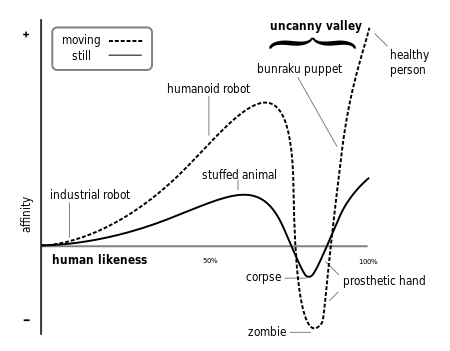The Uncanny Valley: has it been crossed yet?
What is the uncanny Valley? Wikipedia says it is: "(...) a hypothesis in the field of robotics and 3D computer animation, which holds that when human replicas look and act almost, but not perfectly, like actual human beings, it causes a response of revulsion among human observers. The "valley" in question is a dip in a proposed graph of the positivity of human reaction as a function of a robot's human likeness."
First coined by professor Masahiro Mori in 1970, mankind has since tried to create robots and 3d characters that cross this so-called valley. These attempts have been more or less successful, as we shall see. Yet, can the Valley be crossed? Although all people have a basic psychological archetypical structure, one has to take into consideration the subjective nature of people. People perceives things in a purely subjective and original way, entirely different from one another, and these perceptions can shape the way one perceives the Uncanny Valley. So, what one perceives as disturbing, another might perceive as funny, endearing or interesting, without feeling the least bit of repulsion.
As we can see from the above graph, the more human like something is the more repulsed we feel by it,that is, until it crosses over to a real human, at which point we become comfortable again. As we can see, people seem to be irked by the lack of life in the puppets/zombies/3d characters etc. So it's not only a problem of hoe life like something looks but also how life like something comes across/ feels to us. Again, this feeling will be different on a case by case basis. Human perception is formed through experience, so, when something doesn't match our day to day experience (i.e. a 3d character doesn't move in the same way we know humans are supposed to move), the uncanny valley appears.
A few theories on why the valley exists have been proposed:
a. Mate selection: wherein we are biologically designed to reject potential mates that we deem subpar (i.e. infertile) - we are attuned to notice imperfections
b. Mortality salience: the way the "uncanny" robot moves reminds us of our own mortality, of our own transient life .It plays on our fear of death, our fear of not being unique and being easy to replace and in some situations of losing control of our body (jerky movements, weird facial expressions reminiscent of facial nerve paralysis)
c.Pathogen avoidance: The visual anomalies and defects signal to us that the human like creature might carry a desease, thus we feel aversion as a means of signalling that we should avoid it.
d. Sorites paradoxes: We find it difficult to discern when the robot stop becoming a robot (non human) and bomes human.
e. Violation of human norms: a robot which has enough non-human characteristics will be judged as a robot, but, a robot with enough human-lika characteristics to do a passable job as a human shall be judged as a human ( therefore the defects are highly magnified)
f. Religious constructions of human identity: by acknowledging a human like robot we acknowledge that there is no such thing as human uniqueness. This causes existential anxiety, wherein we are reminded of our mortality and our ageing (things which humans then to attributet to others except oneself)
Here are a few examples of the Uncanny Valley in action:
In the end the uncanny valley hasn't been crossed yet but we are on the right track, and, at the rate at which electronics are progressing it is really just a matter of time until someone manages to cross it.

No comments:
Post a Comment